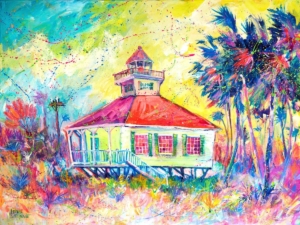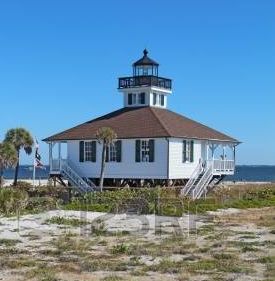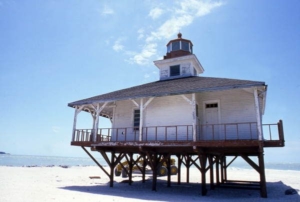 I love all things relating to Southwest Florida and the sea. In addition to mermaids and fish houses built on stout pilings, I also love lighthouses like the one on Sanibel Island. However, this painting is my homage to the Boca Grande Lighthouse. In 2007, it won the “Best Looking Lighthouse” award from Florida Monthly Magazine.
I love all things relating to Southwest Florida and the sea. In addition to mermaids and fish houses built on stout pilings, I also love lighthouses like the one on Sanibel Island. However, this painting is my homage to the Boca Grande Lighthouse. In 2007, it won the “Best Looking Lighthouse” award from Florida Monthly Magazine.
The lighthouse dates back to 1888. In that year, Congress allocated $35,000 for the U.S. Lighthouse Service to build a lighthouse on the southern tip of Gasparilla Island to mark the  entrance to Boca Grande Pass, the deepest natural port in the state. By the time the lighthouse was lit on December 31, 1890, the port at Boca Grande had become the hub for the local phosphate industry, which mined the mineral along the Peace River, placed it on barges, which were unloaded onto ships in Boca Grande Pass for transport to other destinations for processing.
entrance to Boca Grande Pass, the deepest natural port in the state. By the time the lighthouse was lit on December 31, 1890, the port at Boca Grande had become the hub for the local phosphate industry, which mined the mineral along the Peace River, placed it on barges, which were unloaded onto ships in Boca Grande Pass for transport to other destinations for processing.
The wooden lighthouse was constructed atop a series of iron pilings that elevated the structure, protecting it from storms and hurricanes of the Gulf. A square tower was constructed in the center of the one-story dwelling that supported a circular lantern  room inside an octagonal cupola that raised the elevation of the light to 44 feet. The light was an iron screw pile design with wood frame that originally utilized a clam-shaped Fresnel lens that was used to broadcast a white light interrupted by flashes of red out to sea. The lens opened and closed as it rotated.
room inside an octagonal cupola that raised the elevation of the light to 44 feet. The light was an iron screw pile design with wood frame that originally utilized a clam-shaped Fresnel lens that was used to broadcast a white light interrupted by flashes of red out to sea. The lens opened and closed as it rotated.
In 1939, the U.S. Coast Guard (USCG) took over operation of lighthouses from the U.S. Lighthouse Service. During World War II, the lighthouse was used to watch for German U-boats and a submarine watch tower was erected to the west of the lighthouse to facilitate that effort. While it was not reported at the time, as many as 189 merchant and military ships were sunk by subs in the Gulf of Mexico and the Caribbean in 1942 alone.
In 1956 the light was automated, and the era of lighthouse keepers on Gasparilla Island came to an end. The light was deactivated in 1966 and a year later the Coast Guard abandoned the facility, leaving the station to the elements and vandalism until ownership transferred from the federal government to the care of the local county government. By this time, erosion had chewed away at the shoreline along the southern tip of the island which left the screw piles exposed. The light began to tilt, and soon the entire structure was in danger of falling into the Pass.
In 1980, the Gasparilla Island Conservation and Improvement Association was successful in getting the structure placed on the National Register of Historic Places, and set about raising funds for the restoration of the property. The buildings were fully restored in 1985-1986, including the installations of a 377 mm drum lens, putting the old lighthouse back into service as an active aid to navigation.
In 1988 the lighthouse and the land around it was transferred to the State of Florida. Housing a museum that is dedicated to sharing the history of the lighthouse and local area, the lighthouse today serves as the centerpiece of Gasparilla Island State Park. It is one of only six lighthouses in Florida that is open to the public, and the only one on the west coast. Barrier Island Parks Society, a nonprofit Citizen Support Organization, manages and operates the museum.









